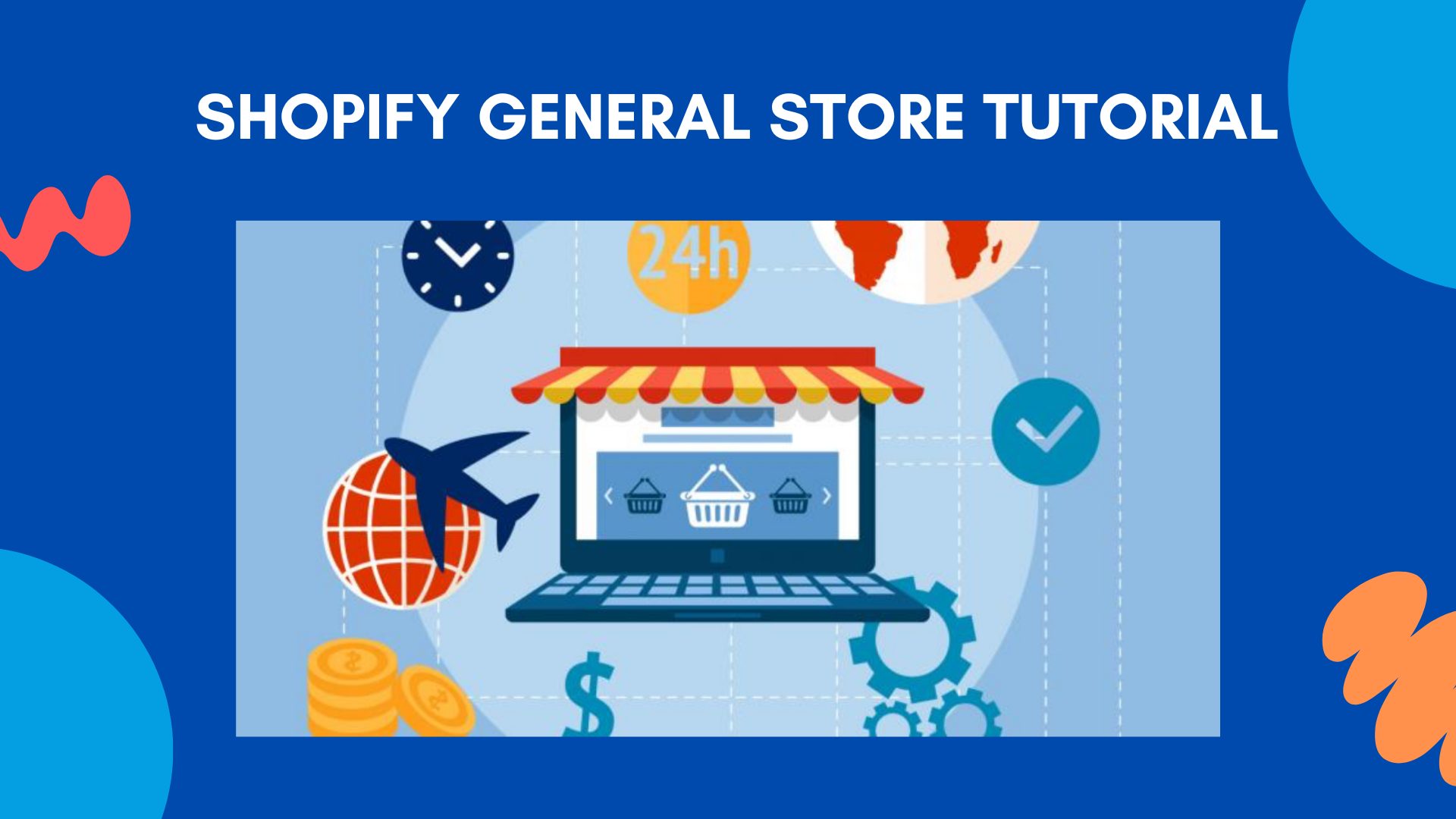Would it be ideal to enter the e-commerce world with a general store? Are general stores profitable? Are general or niche stores better? How to start a Shopify general store?
You are thinking about opening a general store on Shopify, and these questions keep lingering in your mind.
In this article, we will walk you through everything about Shopify general stores, from selecting the right products, a step-by-step guide on building these stores, and strategies for optimizing, promoting, and scaling your stores, to tips to avoid common mistakes.
Before diving into the guides and tips, let’s first understand what a Shopify general store is and which elements make it superior to other business models.
Table of Contents
Understanding the Shopify General Store Model
What is a Shopify General Store?
A general store sells products belonging to different categories, making it quite similar to popular retailers like Amazon, eBay, and Target. This model differs from single-product or niche stores that specialize in offering one specific product or category. Shopify general stores focus on appealing to a broad audience instead of targeting a specific audience.
Shopify General Store vs Niche Store vs One-Product Store
| General Store | Niche Store | One Product Store | |
| Product Range | products across different categories | products belonging to a specific category or market | only one product |
| Target Audience | a broad and diverse audience | niche-focused audience | targeted audience for a single product |
| Branding | difficult to build unique branding due to diverse product categories | focused branding around the niche | strong branding around a single product |
| Marketing Strategy | broad targeting and ad campaigns to approach different customer segments | highly targeted marketing strategies to approach a highly relevant audience | focus on USP marketing with paid ads, influencer marketing, and landing page |
| Scalability | high ability to add more products across categories | can add related products and expand into other relevant niches | difficult to expand new products, but consider product refinement or related services |
| Competition | faces more competition, especially from large marketplaces | less competition, depending on niche popularity | low if the product is unique |
| Profit Margins | low profit margins but high sales volume can generate profits | higher if the store offers high-demand products with less competition | potentially high on the condition that the product is in demand |
Pros and Cons of Running a General Store
From the comparison table, you can see the benefits and limitations of operating a general store compared to other business models.
Pros:
- Diverse product range: covers various categories such as clothing and apparel, electronics, household items, groceries, and personal care that adapt to various customer needs.
- Broad audience appeal: reaches numerous customer segments rather than a specific niche market, which allows
- Experiment with any trending product: allows store owners to test different trending products across various categories.
- Scalable business: gives a great chance to expand the product assortment and adapt to customers’ demands and market trends.
Cons:
- Branding and Marketing: Because general stores provide different types of products and target a broad range of customers, store owners may face difficulties creating a unique brand identity and implementing broad marketing strategies.
Who Should Start a General Store?
While running a general store provides many benefits, this model isn’t the best fit for everyone.
A Shopify general store should be the choice of:
- Beginners who want to experiment with different products and explore which products/niches bring profits. Running a general store is a way to research the market and find customer segments.
- Dropshippers are not burdened by inventory risks, allowing them to explore the sales potential of any trending product. Meanwhile, a general store brings flexibility, diversification, and scalability, making it ideal for dropshipping.
- Experienced marketers who are good at promoting the brand. As mentioned in the previous part, marketing is one of the most challenging tasks when running a general store. Therefore, those who have experience in digital marketing and want to start up a new business can consider opening a general store.
- Versatile entrepreneurs who are able to manage a wide variety of products and have a strong sense of adaptability. They can organize product categories effectively and expand new product trends that meet customers’ demands.
Choosing the Right Products for Your General Store
The choice of products is a vital step that affects the success of a general store. To generate sales for the business, you need to offer items that attract a wide range of customers and meet their needs.
What makes a product suitable for a general store?
Products sold in a general store often have the following characteristics:
- Broad audience targeting: Items having universal demand like groceries, essential apparel or basic household items often attract a broader audience.
- Multi-use products: Versibility is often found in general-store items, meaning they can be used in various contexts and spaces. You should consider selling versatile products such as cleaning supplies, first aid kits, and handy gadgets.
- Affordable prices: Inexpensive items tend to draw in many customers. You can also offer products at different pricing levels to approach more customer segments.
- Easy-to-use items: Universal audience often prefer ready-to-use products or items requiring minimal skillset. Canned food, paper items, kitchen tools, and household cleaners are some suggestions.
- Basic quality: A general store typically sells items of basic quality rather than high-end products. These items don’t need to be luxurious, but they should be functional and durable.
How to find trending & evergreen products
You can use different channels to search for high-demand products. These channels are helpful for product discovery, competition research, and customer behavior analysis.
Social platforms
TikTok, Facebook, Instagram, and YouTube are the most popular channels you should utilize for product research.
- TikTok: Use hashtags like #TrendingProducts, #ViralProducts, #BuyItForLife, and #BestSeller to find high-demand products. Videos with many likes, shares, and comments will tell you which products should be sold.
- Facebook: Follow pages and join groups for your product categories, such as gadgets and tech products, home and kitchen essentials, and beauty and skincare. You can also visit Facebook Marketplace to explore products by category and buy-and-sell groups.
- Instagram: Instagram Shopping, Reels, and Stories are valuable sources that suggest best-selling items. Besides, follow shopping influencers and brand collaborations to get new trends.
- YouTube: Watch unboxing, review, and comparison videos to learn more about products. Then, you should also look at the comments below the videos to understand customers’ pain points and preferences.
Online marketplaces
Amazon, eBay, and Walmart are the top three marketplaces where merchants can discover general e-commerce trends.
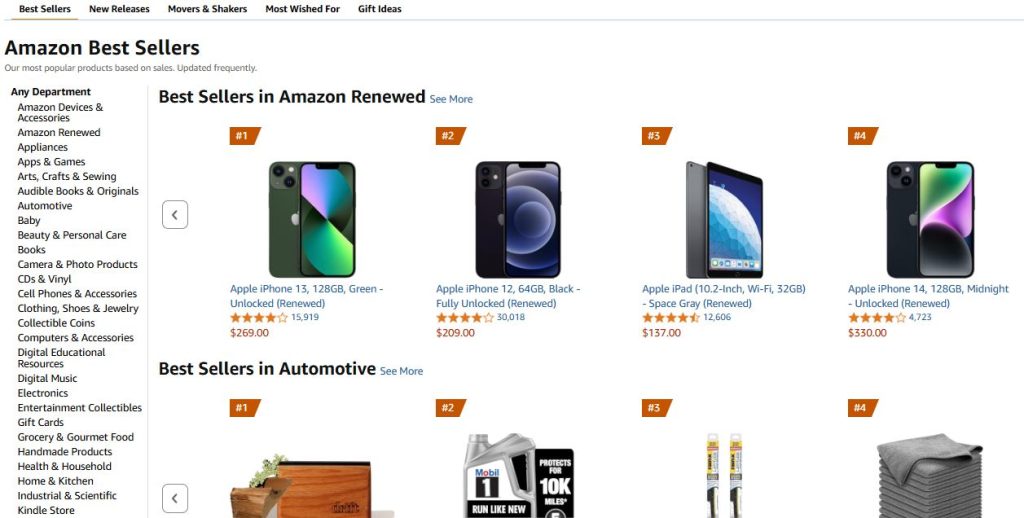
- Amazon: Visit Amazon Best Sellers to explore top-selling products in each category, while Amazon Movers & Shakers lets you see top-rising products in sales. Read customer reviews to learn the pros and cons of products, from which you can find improvement opportunities.
- eBay: Visit eBay Trending to find popular searches and best-selling items. This platform also provides information about the sales frequency of each product. You can refer to Auction and Fixed Price Listings that provide valuable insights into product pricing and demand.
- Walmart: Walmart Best Sellers is the place to see the best-selling items. In addition, you can refer to custom reviews to gain insights, discover trending features and improvements, and identify customer pain points and preferences.
Tools for Product Research
Using the tools below helps you learn about trends in the e-commerce market.
- Google Trends: Allows setting the time frame to see short-term trends or long-term demands. Depending on your target regions, you’ll check keywords in specific countries or worldwide.
- Exploding Topics: Categorizes keywords by industry and identifies early-stage trends before they go viral, helping merchants stay ahead of market trends. It also helps to check popular keywords over time.
- Google Keyword Planner: Provides keyword metrics such as search volume, regional data, competition level, and CPC. Based on these metrics, you can determine the trend and popularity of products.
- Ahrefs/SEMrush: These are two powerful tools for keyword research and competitor analysis. With dozens of great features, they help users to find potential keywords, spy on competitors’ stores, and track market trends. However, you need to spend a considerable amount to use these tools.
Best product categories
If you decide to run a general store on Shopify, it is recommended to consider the product categories that are likely to reach a broad audience. They are:
Tech Gadgets
In the digital age, consumers are hunting for seamless digital experiences. High-margin products like smartphones, smartwatches, fitness trackers, and smart home devices are selling better than ever.
Fashion Accessories
Clothing styles and trends are diverse and different over time. Engaging in this market helps you continuously gain new and repeat customers. Selling fashion accessories in season significantly helps increase revenue. What’s more, upselling and cross-selling can be applied to gain more profits.
Home essentials
Home essentials bring convenience and unique style to the house, making people willing to invest in them. You can create bundles such as kitchen tool kits, living room sets, or a smart cleaning duo to sell more.
Pet Supplies
Since people spend a lot of time caring for their pets’ health and comfort, all pet services are thriving today. It would be a worthwhile idea to include pet products in your store. You can also divide pet supplies into subcategories like hygiene, furniture, training devices, and toys.
Health and Wellness
There has been a considerable increase in demand for supplements, skincare, and fitness products in recent years. It is estimated that the health and wellness industry will achieve USD 568.41 billion in 2025 and reach USD 1,074.78 billion by 2034. That’s an impressive number, isn’t it?
Beauty and Cosmetics
Beauty & cosmetics is one of the most flourishing industries. Merchants can earn substantial profits from selling facial cleansers, toners, lipsticks, hair growth serums, teeth whitening kits, and biodegradable face wipes because these products bring frequent repeat purchases.
Outdoor Adventure Gear
Weekends are the ideal time for families and friends to join outdoor activities like camping, adventure, or trekking. Instead of selling single items, creating a bundle including a tent, a sleeping bag, and a camping stove will increase revenue per sale.
Setting Up Your Shopify General Store
Below are the five basic steps to create a Shopify general store. Let’s explore them now!
Step 1: Create a Shopify Account
- Go to Shopify.com and click Start free trial at the top right.

- Sign up with email, Google, Apple, or Facebook
- Answer Shopify’s questions
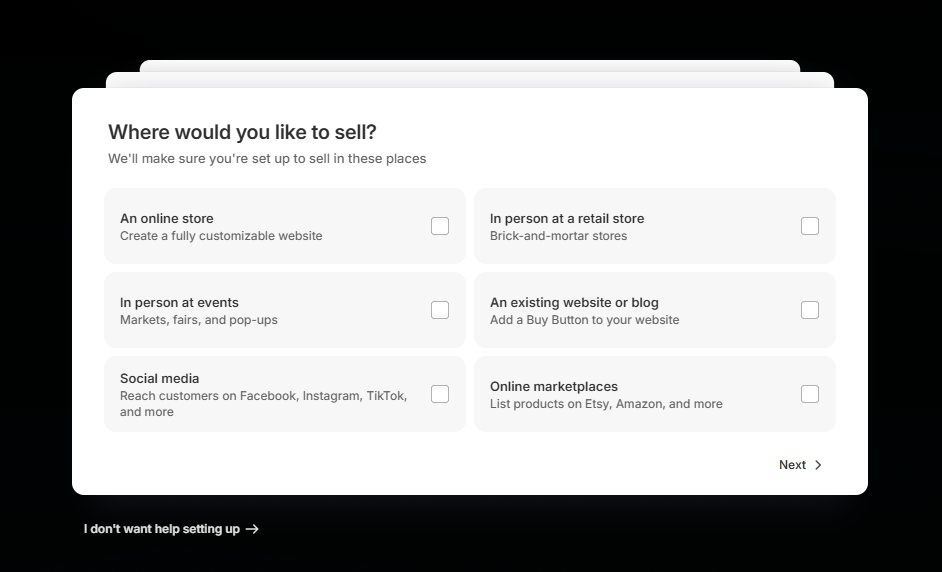
- Choose a Shopify plan (you can skip and do it later)
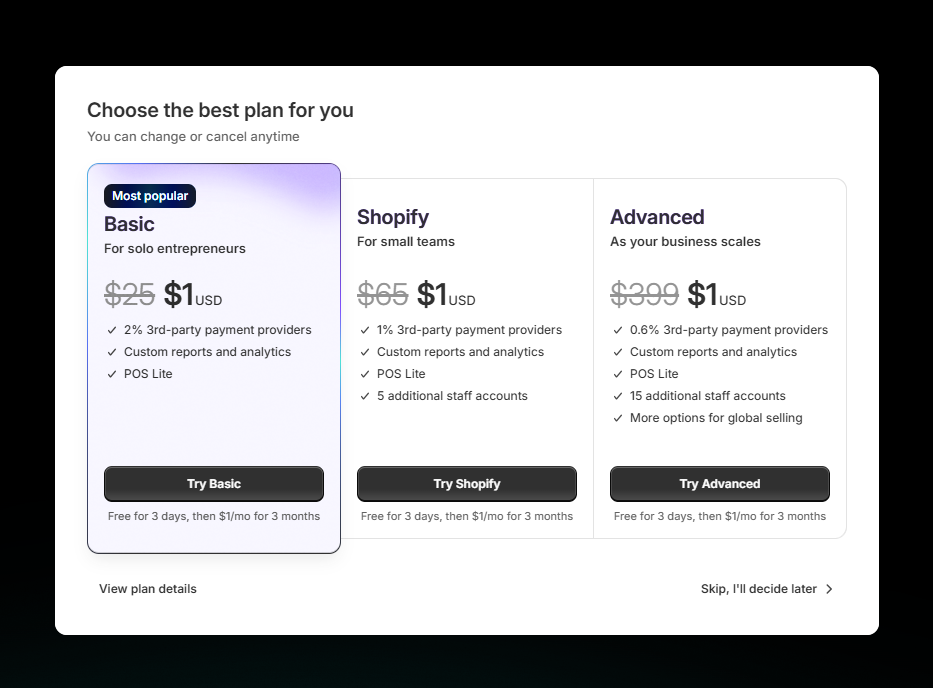
You have created a Shopify account. Now you can visit the Shopify dashboard and continue other steps to complete your Shopify store.
Step 2: Selecting the Best Theme for a General Store
Next, choose a theme to create your storefront without coding. A minimalist theme with a clean design offers easy navigation and effective product showcasing.
There are more than 10 free and 200 paid themes being sold in the Shopify Theme Store. You can use free themes for market testing, small-sized stores, or a modest budget. Meanwhile, premium themes are great for large product catalogs, advanced features, and unique designs.
You can refer to some of the best premium Shopify themes offered by BoostifyThemes for general stores, including Strong, Purely, Noire, and Neat. Our themes are built with clean layouts, flexible customization options, and fast performance — ideal for showcasing diverse product categories. They support full Online Store 2.0 compatibility, allowing you to drag-and-drop sections, adjust design elements easily, and create a professional-looking storefront without coding. With built-in conversion-boosting features and modern design standards, these premium themes give general-store owners a solid foundation for long-term scalability and higher sales.

Step 3: Adding Products to Your Store
Products that engage customers and drive sales are the core of your Shopify store.
From your Shopify dashboard, go to “Products,” then click on “Add product” or “Import” (when uploading products from your CSV file).
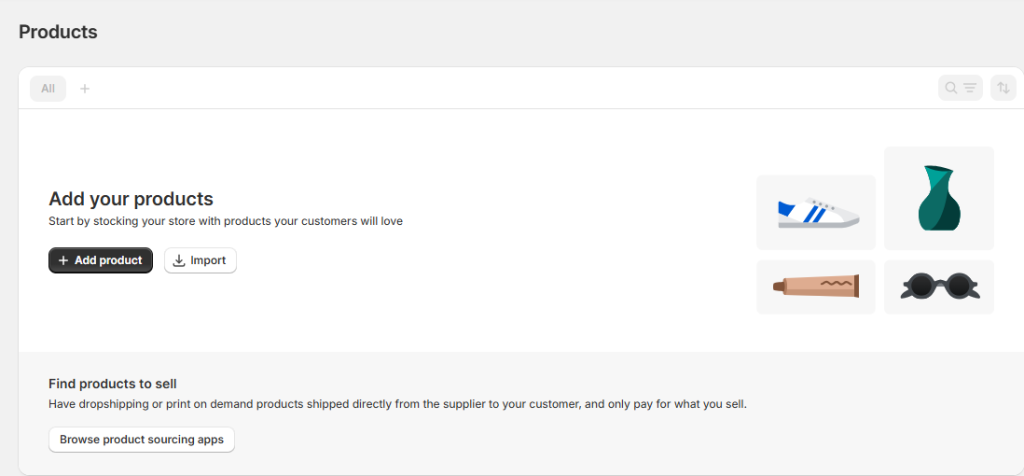
You will be taken to a window where you can add your product details.
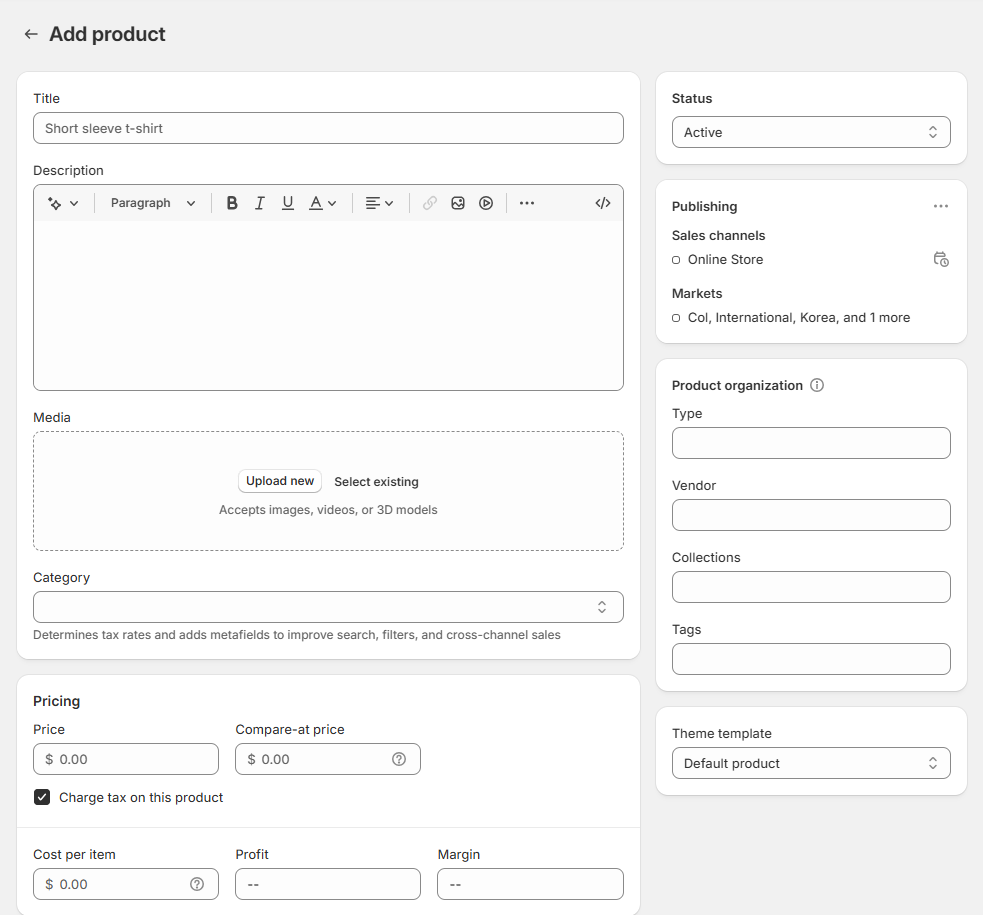
- Add product titles and descriptions: Include keywords to enhance product visibility. Engage customers with the best-selling points and use bullet points to highlight key features & benefits in the description box.
- Add media: Upload images, videos, or 3D models. Ensure high-resolution media.
- Pricing: Complete 5 fields in this section, including Price, Compare-at price (the original price, shown as a discount), Cost per Item (the cost to make or buy the product), Profit, and Margin.
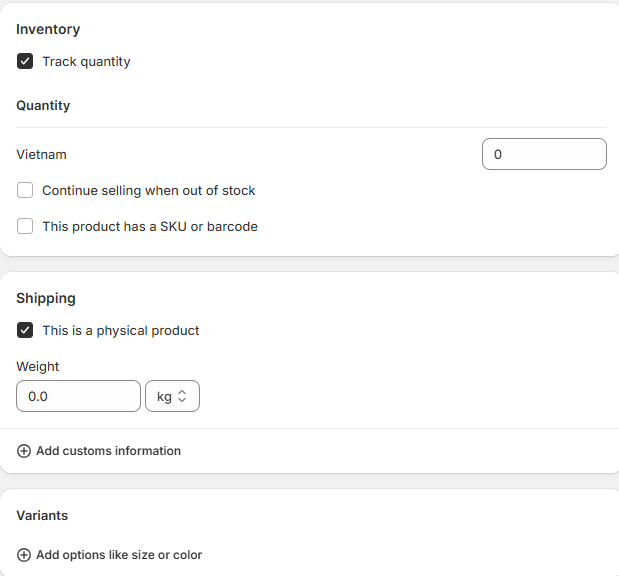
- Inventory: Select “Track Quantity” if you want to manage inventory. Fill in a SKU or barcode (if applicable). Enable “Continue selling when out of stock” if your store applies pre-orders or operates on dropshipping.
- Shipping: weight and customs information such as Country/Region of origin and HS codes.
- Variants: allow selling a product in multiple options like size or color.
Step 4: Create Product Categories
This is an essential step for a Shopify general store.
From your Shopify Admin, go to Products > Collections, then click Create collection.
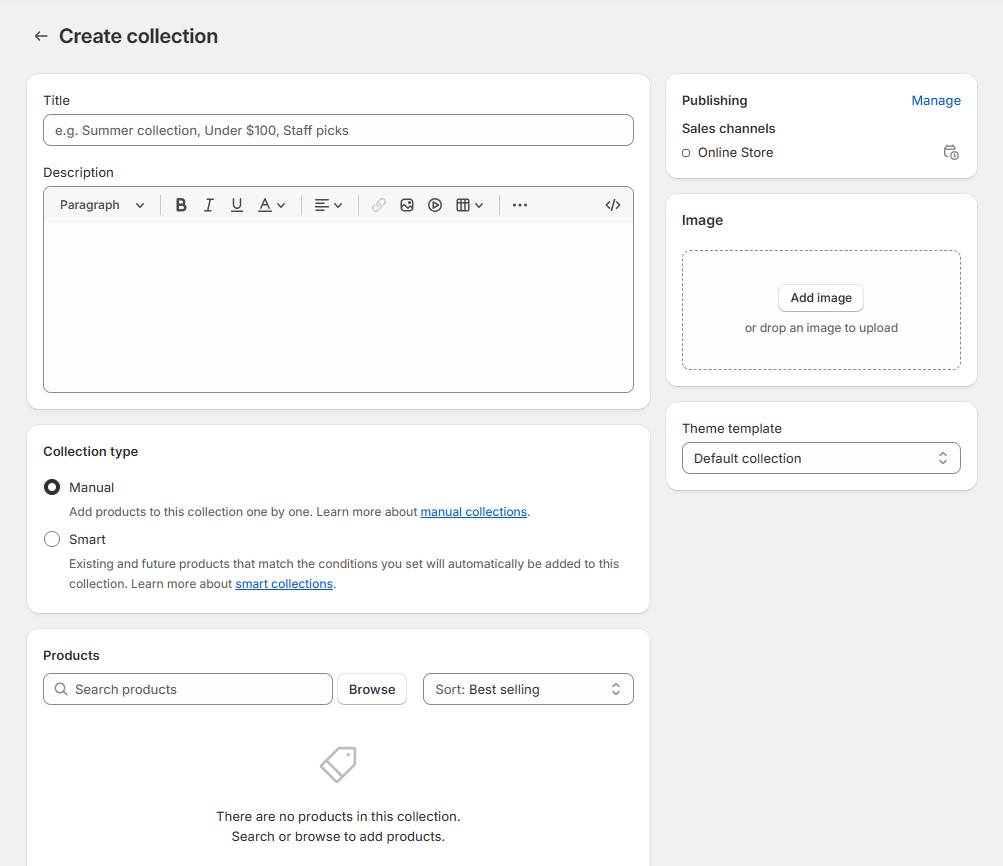
You’ll cover the fields, including the title, description, and collection type. For the collection type, you can manually add your products or use the “Smart” feature to add products based on conditions like tag, title, or price.
Add collections to your menu to make customers navigate your store easily. To do that, go to Online Store > Navigation, select Main Menu or create a new one, and add menu items where you can choose the collections you want to display on the menu.
Step 5: Setting Up Essential Pages
Homepage
This is a crucial page in Shopify general stores. Here are things to consider when setting up your Shopify homepage:
- Header: In addition to text, you can use images and video banners to create an impression on visitors
- Navigation: The homepage is an ideal place to guide visitors around your website. It should link to all important pages, including best-selling products, Collections, About Us, Contact Us, and Cart.
- Call to action: CTA buttons should be designed properly and intuitively to navigate visitors to different places on the website.
- Featured Products: Visually showcasing popular products is a good way to attract visitors. It is also necessary to place them strategically with high-converting CTAs or offer discounts to boost sales.
- SEO Optimization: This is a smart SEO strategy to build your store’s trust and credibility. Branded keywords, product category keywords, and local keywords are some types of keywords that should be optimized for the homepage.
Product pages
In addition to covering all the fields for “Add Product” pages, you should optimize them with:
- Media: Add product images from multiple angles, zoom feature, lifestyle images (product in real-life context)
- Customer reviews: Use Shopify review apps like Loox and Trustoo to show social proof, ratings, and testimonials
- Upselling and Cross-selling: Recommend similar products or offer bundles to increase average order value.
- SEO optimization: Optimize keywords in product titles, descriptions, and images to increase visibility for product searches
- FAQ section: Answer common questions about the product that help customers understand more about your product.
Other pages
Step 6: Configuring Payment & Shipping Settings
In addition to selling products, the payment and delivery process need to be set correctly to enable smooth checkout and fulfillment.
- Choose a payment gateway: Go to Settings > Payments and activate Shopify Payments. Check if this option is available in your country. If not, you can use an alternative option such as PayPal, 2Checkout, or Stripe. You also use a Shopify payment app to enhance the payment experience.
- Set up shipping settings: Go to Settings > Shipping and Delivery to configure shipping rates, shipping labels, expected delivery dates, local delivery, and other settings. You can integrate an order fulfillment app to support the shipping process.
Optimizing Your General Store for Sales
Choosing a Conversion-Focused Shopify Theme
Because you’re running a general store, it is advisable to select a Shopify theme that fits almost all product types. Shopify themes with minimal design and large product catalogs will meet your store’s demand.
Besides, your theme should include advanced features that support marketing and conversion, product discovery, and checkout.
Installing Sales-Boosting Shopify Apps
Installing Shopify apps can help enhance store functionality and improve customer experience. Below are some app categories you should install for your store.
- Referral & Affiliate Apps
- Store Design Apps
- Sales and Conversion Apps
- Order Fulfillment Apps
- Product Management Apps
- Payment Apps
- Review Apps
- Customer Support Apps
Optimizing Your Store for SEO
It is essential to increase your store’s visibility on search engines, as they are a potential channel for reaching customers.
First, you need a keyword set for all the important pages, including:
- Homepage: branded keywords and head terms
- Product Pages: Product-specific, targeted keywords
- Collection Pages: Category keywords
- Shopify Blog: Long-tail, extended keywords
Next, optimize these keywords for titles, URLs, descriptions, content, and images.
You can also use Shopify SEO apps to optimize your general store more effectively.
Building Engaging Elements
Here are some elements you should consider including in your store. They will boost customer engagement to bring sales.
- Eye-catching hero sections: Apart from an appealing headline, you can add an image or video banner, and strong CTA buttons.
- Gamified Popups: Some popup ideas like Spin to Win Wheel, Mystery Box Reveal, and Scratch & Win will help collect customers’ emails.
- Real-time social proof: An effective way to build trust for a store with a range of products. You can display live purchase notifications, live reviews, or star ratings popups to draw the attention of customers.
- Shoppable videos: Videos are more engaging than text and images, making them a powerful tool to turn views into sales. Add product details or an ‘Add to Cart’ button directly to your videos to drive faster conversions.
- Topbar Announcements: You should utilize this ideal position to display flash sales, free shipping, BOGO offers, or limited-time deals.
Top Marketing Strategies for Your General Store
Organic marketing
Paying for ads will generate sales quickly, but you can’t always rely on paid ads alone. A long-term, non-paid approach is essential for general stores. It is necessary to build organic marketing strategies through SEO, email, and social media to increase brand awareness and gain customers naturally.
These marketing strategies require investing time and effort in content. Read more at Content Marketing for eCommerce: Roadmap & Best Practices.
Paid advertising strategies
Paid advertising will help store owners reach a larger audience. First, you need to choose the right ad platform:
- Social media ads: Facebook, Instagram, TikTok, and YouTube Ads
- Search engine ads: Search Ads, Shopping Ads, and Brand Campaigns
- Retargeting / Remarketing Ads: Cart Abandonment Campaign, Product Viewer Campaign, and Cross-Sell / Upsell Campaign
- Influencer Paid Promotion: Sponsored posts, affiliate campaigns, or micro-influencers
- Affiliate & Referral Ad Strategy: UpPromote is a powerful Shopify app for affiliate and referral programs.
Email campaigns
Email marketing is one of the most effective channels for boosting sales. You can create email campaigns to promote new products, offer discounts, and recover abandoned carts.
You can use the built-in email marketing tool called Shopify email or other third-party apps such as Klaviyo, Shopify Email, and Omnisend, which help personalize and automate your marketing emails.
Managing & Scaling Your General Store
To manage your general store efficiently, you must streamline the fulfillment process, manage inventory, and improve customer support. You are recommended to install Shopify apps:
- For dropshipping stores, Spocket can automate the product sourcing and order fulfillment process.
- Stocky is the inventory management app for tracking stock levels, avoiding stockouts, and managing restocking efficiently.
- Set up automated alerts for low stock items and reorder points to keep your product catalog fresh without overstocking. You can use Shopify apps like Stockbot Inventory Forecasting or Stockie Low Stock Alert.
- Use Zendesk for efficient customer support. It can automate responses to common questions and manage customer service tickets.
With a general store, you can easily expand your product offerings
- Use tools like Google Trends, SaleHoo, and AliExpress for trending product research: They can track trends in various niches. From the collected data, add products that align with your target audience’s interests.
- It is advisable to diversify suppliers because it ensures your products stay competitive in terms of pricing and shipping times. Buddify: Partner Dropshipping will help you a lot.
Common Mistakes to Avoid When Running a General Store
The following are the most common mistakes of a general store:
- Lack of Branding Focus: A general store often sells a range of products. You may have difficulties building a unique brand identity. The solution is to focus on establishing a strong brand voice and consistent visuals to unify your store’s identity.
- Too Many Categories/Products: Don’t sell everything with your general store. Please research carefully and select potential items. If not, your store could feel disorganized and overwhelming to shoppers.
- Poor Inventory Management: For a general store, inventory management is a daunting task because stockouts lose sales while overstocking ties up capital. You are recommended to set up automated low stock alerts and forecasting tools for inventory optimization.
- Poor Investment in Marketing: General stores often don’t provide unique products. Therefore, you should diversify your channels — SEO, email marketing, social media, and influencer outreach to approach potential customer groups.
Shopify General Store FAQs
How do I choose products for my general store?
Use tools like Oberlo or DSers to find trending products and their market demand. Dropshipping is an ideal model to reduce the initial investment. Besides, refer to AliExpress or other wholesalers (for product cost), Shopify payments (for transaction fee), and competitor stores (for target sale price) to estimate product margins.
What are the advantages of a general store vs a niche store?
A general store offers a variety of products and targets different markets. It can adapt to trends and sell multiple categories.
For a niche store, you’ll focus on a specific customer group, making it easier to create a strong brand, set up targeted campaigns, and build customer loyalty.
How do I avoid overwhelming customers with too many products?
In Shopify, organize your catalog into clear categories and subcategories (e.g., Home & Garden, Tech & Gadgets, Fashion).
You can use a Shopify filter and search app to enhance the navigation and menus so customers can easily browse your store.
Best-selling and seasonal products should be highlighted on your homepage so that customers can quickly find them.
In Conclusion,
Our complete guide has highlighted almost everything about a Shopify general store:
- Its advantages over other store models
- Product and category selection
- Store setup
- Store optimization tips
- Best marketing strategies
- Inventory management
- Store scaling methods
- Common mistakes to avoid
We hope that this knowledge will help you build and grow a successful Shopify general store.

